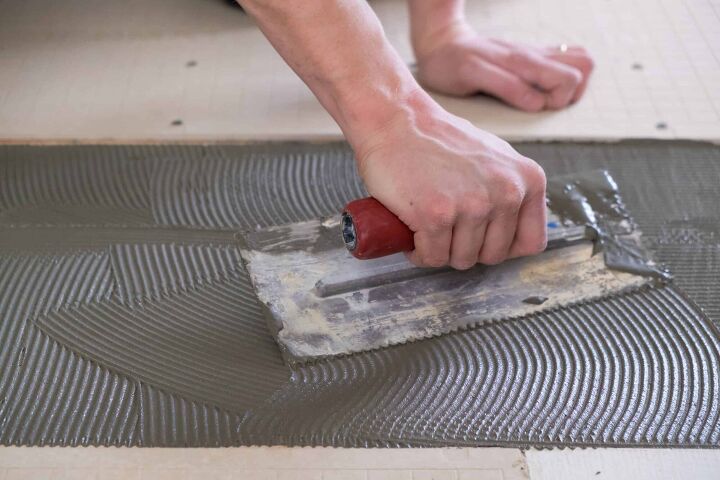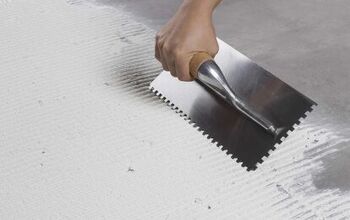Modified Thinset Vs. Unmodified Thinset: Which Is Better?

If you’re preparing to undergo a DIY tile job, one of the items on your shopping list is likely mortar. However, should you get modified or unmodified thinset? The type you choose will depend on your project and how much strength and flexibility you will need.
Modified thinset is ideal for stone and tile work because it contains special polymers that make it strong and easy to work with. Professionals also use unmodified thinset or mortar, and it consists of a simple mixture of sand, water, and Portland cement. The additional retention of modified thinset makes it more durable and versatile.
Both modified and unmodified thinset are useful for many projects, but it can be difficult to choose between them. It may seem obvious to choose modified thinset for durability, but that isn’t always necessary. Follow along as we explore the differences between modified and unmodified thinset.
Is Your Thinset Modified Or Unmodified?
Most of the time, when you purchase thinset, you should be able to tell from the packaging if the thinset is modified or unmodified. Sometimes, unmodified thinset will be referred to as dry-set mortar. If you are unsure, pay attention to the ANSI (American National Standards Institute) number on the product. ANSI numbers are only standardized codes that help ensure a uniform system of identification.
For thinset, the code is A118.1, which represents all unmodified thinset. You might see something like this – “product meets ANSI A118.1 when mixed with water.” If there is more than one code on the bag, then it is modified thinset. Some of the ANSI codes that designate a product as modified thinset are A118.14, A118.11, and A118.15.
Important Note
In some cases, unmodified thinset can have two or more codes listed on the product. If this happens, there will also be additional information present regarding the regulations.
This extra info states the specific product only meets the modified thinset if it is mixed with a liquid latex add-in.
How Is Modified Thinset Made?
Unique retention compounds added into the thinset make it a modified thinset. One of the most prevalent compounds is hydrated lime, which allows the cement to retain water for a much longer time than other additives.
Polymers are added in either a powder or a liquid form. If the polymer is a liquid, it is mixed with the thinset in place of water. If the polymer is a powder, it is included in the thinset and activated later when water is added to the mortar.
What Thinset Is Right for You? It Depends On What You Are Installing
Remember, thinset needs moisture in order to harden and achieve enough strength and resistance. If you are installing a backsplash or wall tiles, a modified thinset is an excellent choice.
If you are working with waterproof elements, then unmodified thinset is likely your best bet. Examples of these types of situations are installing a shower substrate or using an uncoupling membrane under your tile.
An uncoupling membrane is a waterproof material that is often used in floor tile applications. Since this membrane provides an impervious layer, it helps the unmodified thinset retain its moisture.
Modified Thinset
Modified thinset needs air to cure appropriately; therefore, using it between two waterproof surfaces makes it difficult for it to set. In the above scenario, modified thinset could potentially take up to 60 days to cure.
You can attribute the long dry time to the fact that the thinset would only have access to air through grout joints. Therefore, when you are prepping for your tile job, consider where your tile is going and what materials will be used.
How Are Modified And Unmodified Thinset The Same?
Although modified and unmodified thinset are two different products, they both share a couple of similarities.
- [b]They both contain a mixture of cement, sand, and a water retention agent. The ratio of these elements can differ, but all three are present in every thinset. How much cement is in a thinset is the main factor that determines its strength.[/b]
Whether you use modified or unmodified thinset, the strength depends on the cement ratio to sand within the mix. A high-quality thinset will have more cement than sand, which makes it sturdier and provides more adhesion.
- You can apply unmodified and modified thinset the same way. Whether you use unmodified or modified thinset, the application is roughly the same. However, there are some modified thinsets that do come premixed.
Modified vs. Unmodified Thinset
While an unmodified thinset is the way to go if laying tile on a waterproof surface, what if you are installing a backsplash or tiled walls? Is one option a better choice, or does it just become a matter of personal preference? The answer is both.
There are definitely several things to consider, such as:
- Workability
- Durability
- Versatility
- Cost
Workability
You can work with modified and unmodified thinset largely in the same way. You have to mix both in small batches and work in stages. It is best to work in a small area at a time since the thinset hardens in about 20 minutes.
One difference is, some modified thinsets come pre-mixed, which would translate to less work for you. There are also some additives that you can put into some unmodified thinset to increase the retention properties. However, overall, the actual application process of these two products is fairly similar.
The Winner: Tied
Durability
Unmodified thinset is recommended in specific waterproof settings and is exceptionally durable in these situations. However, modified thinset contains unique properties to increase its water retention abilities, making it extremely strong and flexible.
Increased flexibility helps keep thinset from shrinking and expanding, which in turn prevents cracked tiles.
The Winner: Modified Thinset (in most applications) – Unmodified Thinset (in waterproof applications)
Versatility
Unmodified thinset is the winner for waterproof applications and most floor installations using waterproof underlayments. However, modified thinset is an excellent choice for porcelain tile and other tile types with its increased resistance and flexibility. Modified thinset is also an ideal choice for a variety of different tile installations.
The Winner: Modified Thinset
Cost
When it comes to how much thinset costs if you compare apples to apples, modified thinset is usually slightly higher. In other words, if you take the same brand and the same amount of thinset, you’ll pay a bit more for the modified version.
However, using modified thinset can often translate to less work and time spent, making the slightly higher price tag worth it. It’s really a matter of personal preference in most cases. Do you want to spend less money or less time working on your project?
The Winner: Modified Thinset (the slightly higher price tag is often worth the added strength and decreased work time, making modified thinset a good value – just not in waterproof installations)
Related Questions
Should I use modified or unmodified thinset?
You should use modified thinset if you are working with a subfloor. It is ideal to attach tiles to a membrane with unmodified thinset when modified thinset would be too much. Use unmodified thinset if you work with nice materials such as porcelain.
Is modified thinset waterproof?
Modified thinset is not waterproof, but it is highly water-resistant. The latex polymers in modified thinset make it more durable, flexible, and able to withstand moisture. Waterproof flashing mortar does exist, and it is primarily used for plumbing fixtures.
Does thinset color matter?
Thinset color only matters if you want it to match the color of the tile. The thinset won’t change color once it dries, and it is generally too late to change anything once it sets. It is ideal to pick a color for your thinset that matches or contrasts the tile so that it looks good.
Summing It Up
Modified thinset is more durable and water-resistant than unmodified thinset. There are acrylic polymers in modified thinset that make it ideal for working with subfloors. However, modified thinset may be more than you need if you are simply laying tile.
Modified thinset is more useful when you work with a shower or an area that gets wet. However, unmodified thinset is generally easier to work with and better looking for porcelain tiles. Installation and application is the most important when you work with thinset whether it is modified or unmodified.
Related Guides

Stacy Randall is a wife, mother, and freelance writer from NOLA that has always had a love for DIY projects, home organization, and making spaces beautiful. Together with her husband, she has been spending the last several years lovingly renovating her grandparent's former home, making it their own and learning a lot about life along the way.
More by Stacy Randall



























